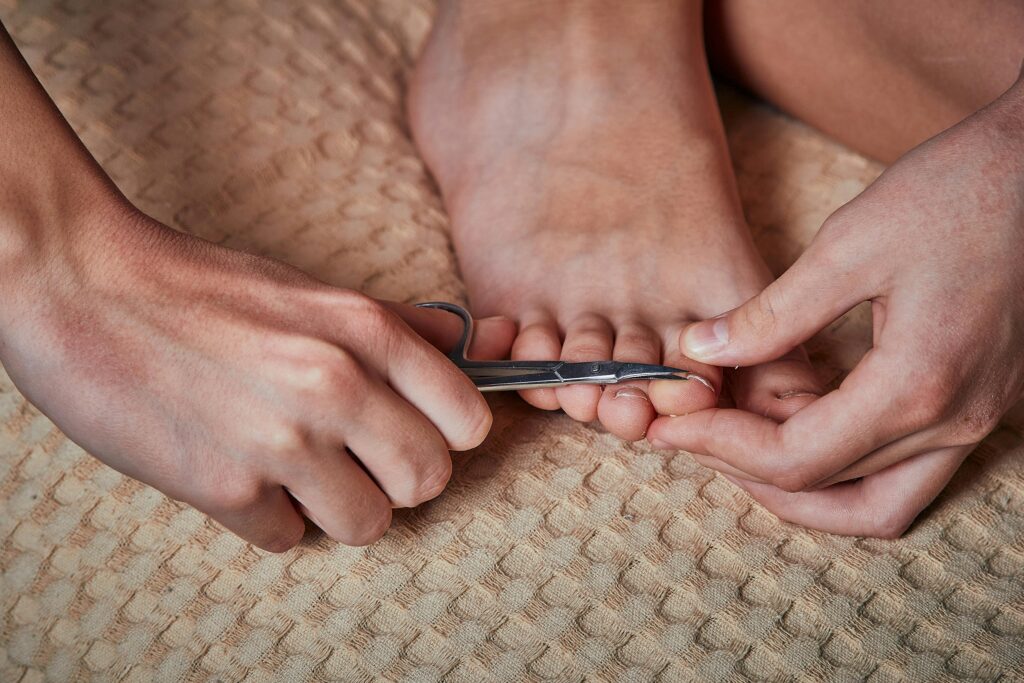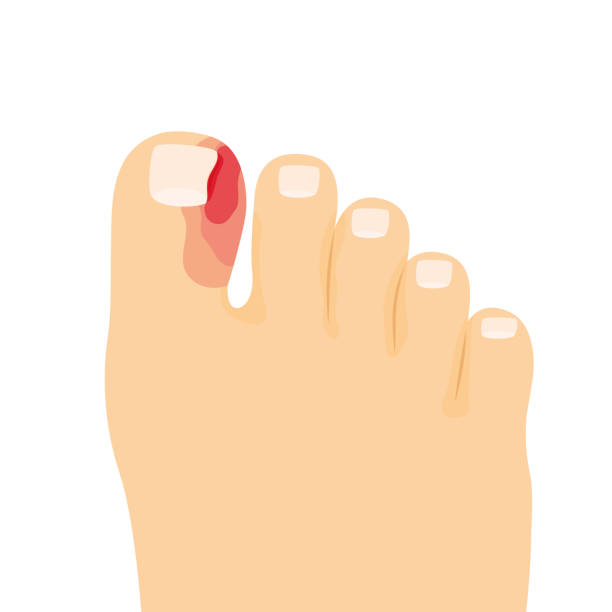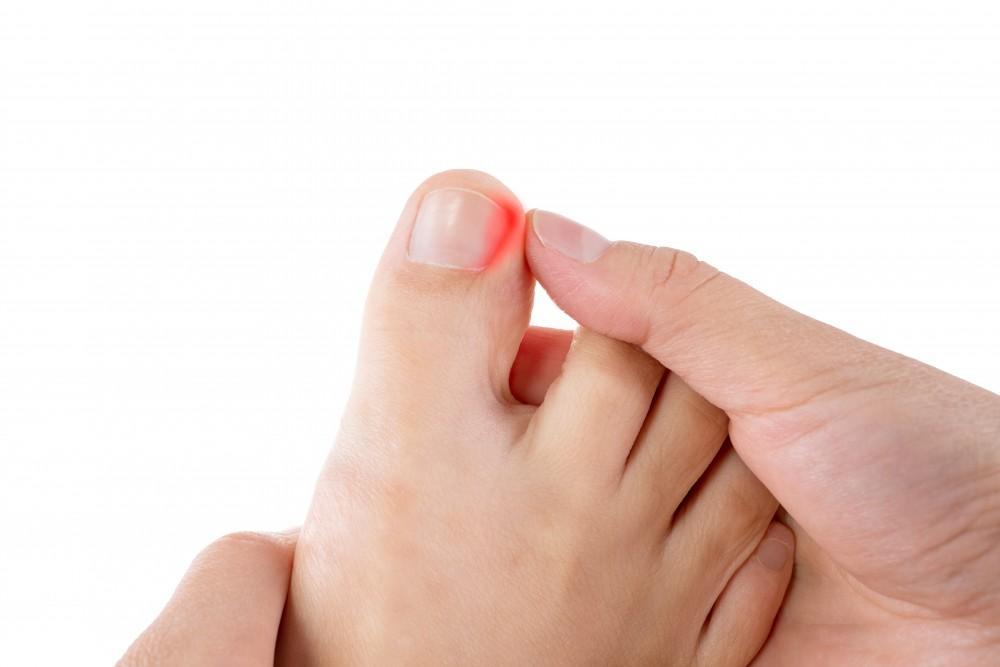Ingrown Toenail
Ingrown Toenail
Table of Contents
What is an Ingrown Toenail?

An ingrown toenail occurs when the edge or corner of a toenail grows into the skin, instead of over it. This condition most commonly affects the big toe and can range from mild discomfort to severe pain, redness, swelling, and even infection.
Ingrown toenails can interfere with daily activities like walking or wearing shoes.If you suspect you have an Ingrown toenail, it is important to see a podiatrist for proper diagnosis and treatment. Untreated ingrown toenail can lead to complications such as infection.
What causes ingrown toenails?

Several factors can lead to an ingrown toenail include
Improper nail trimming (cutting nails too short or curved)
Tight footwear or high heels that crowd the toes
Injury or repeated trauma to the toe
Genetics — some people naturally have curved or thick nails
Poor foot hygiene
Excessive sweating (which softens the skin around the nail)
People with diabetes or circulation issues are especially vulnerable to complications from untreated ingrown nails.
What are the symptoms?

An ingrown toenail typically starts with mild irritation and may progress to more serious symptoms, such as:
Pain or tenderness along one or both sides of the nail
Redness and swelling near the affected nail
Skin growing over the nail edge
Drainage of pus or fluid, especially if infected
Throbbing pain or warmth in the toe
Difficulty wearing shoes or walking comfortably
Infected ingrown toenails can lead to serious complications, particularly in diabetic or immunocompromised patients.
How is an ingrown toenail diagnosed?
Ingrown toenails are diagnosed through a thorough physical examination by a podiatrist who will assess for signs like redness, swelling, pain, or discharge. In some cases X-ray maybe used to assess the depth of the ingrown nail and to rule out other conditions such as sublingual exostosis, a bony growth under the nail.
Can ingrown toenails be prevented?
Yes! You can reduce your risk with these simple steps:
Trim nails straight across — not rounded
Avoid cutting nails too short
Wear comfortable, roomy shoes
Keep feet clean and dry
Avoid trauma or repeated pressure on the toenails
Get regular foot checkups if you have diabetes or circulation problems
FAQs about Ingrown Toenails
Q: Can I treat an ingrown toenail at home?
A: Mild cases may respond to home care, but if there’s pain, swelling, or pus, you should see a podiatrist.
Q: Is the removal procedure painful?
A: No. The area is numbed with local anesthesia, and most patients feel little to no discomfort during or after the procedure.
Q: How long is the recovery?
A: Most patients resume normal activities within a day or two. Full healing can take a few weeks, depending on the treatment.
Q: Will it grow back?
A: If only a portion of the nail is removed, it may grow back. Matrixectomy prevents that portion from returning.
Our Reviews
EXCELLENTTrustindex verifies that the original source of the review is Google. Dr Rahman is an amazing physician! Very patient, friendly, takes time to listen, and offers great expertise. Highly recommend Dr Rahman to those seeking a podiatrist.Trustindex verifies that the original source of the review is Google. Courteous and professional staff. Took me right in. Dr. Rahman was fantastic and put me at ease. Highly recommend if you have problems with your feet.Trustindex verifies that the original source of the review is Google. Dr. Rahman was amazing. She was very informative, proactive, and helpful. I came in and received care the same day, really instantly. Treatment was gentle. She also gave me clear instructions for home care afterwards.Trustindex verifies that the original source of the review is Google. Dr. Rahman made me feel very comfortable and at ease when I am normally very anxious and sensitive with my feet. She was gentle and took her time with me (which is very hard to find these days with doctors!) She also tried to prevent removing my nail by trying every avenue to save it, where many doctors just jump straight to removal as a solution. I am so grateful I found Dr. Rahman. I wish more doctors could be like her! Thank you for taking your time to listen to me as an individual.Trustindex verifies that the original source of the review is Google. Excellent experience! Dr.Rahman is the best and is always willing to go above and beyond. Highly recommend 10/10, she cares so much about making sure that you leave with comfort and care.Trustindex verifies that the original source of the review is Google. I have long COVID and have been to more doctors offices over that past four years than most people would see in a lifetime. I have found the doctors to be very caring and genuinely engaged in my recovery and well-being. I happy to report that Dr. Rahman from Toetal Podiatry foots that bill as well. ;-) That said, the same can not be said about the administrative staff at many facilities. Toetal's staff is the exception. They are universally the best I have ever experienced. They are always pleasant, cheerful, engaged, helpful and proactive. Whether you are constantly in pain or not, this type of treatment is alwasy welcome and appreciated. If you are looking for a Doctor's office that takes patient care to the next level -- it starts with Dr. Rahman and continues throughout her staff. Your feet are in good hands here.Trustindex verifies that the original source of the review is Google. ⭐️⭐️⭐️⭐️⭐️ Highly Recommend – Amazing Experience for My Son with Autism We had a wonderful experience with this podiatrist. My 18-year-old son, who has autism, was dealing with an ingrown toenail, and I was nervous about how the visit would go. From the moment we arrived, the entire team made us feel at ease. The doctor was calm, patient, sweet, and extremely professional. She was quick, efficient, and clearly experienced—everything was done in a way that kept my son comfortable and calm. Her gentle and reassuring manner made a huge difference, and she clearly knows how to work with individuals with special needs. The secretary was absolutely amazing—so kind and supportive. My son was scared, and she took the time to speak with him, reassure him, and help him feel safe. The whole staff showed such care and understanding. The office is conveniently located, very close to the train station, which made getting there so easy. Because of my son’s autism, I truly appreciate professionals who are prepared and thoughtful, and this doctor and her team exceeded our expectations. This was the best place we could have gone, and I highly recommend them to anyone—especially families with children or teens with special needs.Trustindex verifies that the original source of the review is Google. I had a great overall experience at Toetal Podiatry! The whole staff is very friendly and helpful! Dr. Rahman is a great doctor. She is very empathtic, solution focussed and has a positive attitude! She took the time to thoroughly explain everything to me . I higly recommend this office! The whole experience exceeded my expectations!Trustindex verifies that the original source of the review is Google. Clean cozy and bright environment. Friendly staff and informative podiatrist.
Our Locations
Contact Us
- 917-261-4291
- 917-594-4881
Locations
- 274 Madison Ave #1001, New York, NY 10016
- 26 Broadway Suite 931, New York, NY 10004

